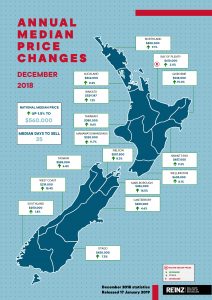PHOTO: REINZ PRESS RELEASE
In December 2018, the number of houses sold across New Zealand decreased by -12.9% year-on-year to 5,330, down from 6,117 – 787 fewer houses.
For New Zealand excluding Auckland, the number of properties sold decreased by -8.2% when compared to December 2017, from 4,352 down to 3,994 – 358 fewer houses and the lowest for the month of December in 5 years.
In Auckland, the number of properties sold decreased by -24.3% year-on-year and was the lowest for the month of December in 10 years.
Bindi Norwell, Chief Executive at REINZ says: “While December is usually a quiet month as people focus on Christmas holidays, December 2018 was extremely quiet with the lowest number of properties sold for the month of December for seven years. Additionally, 12 out of 16 regions saw an annual decrease in the number of properties sold.
“With national listing levels down -11.3% in November and -13.3% in December, it’s not entirely surprising that December was a quiet month in terms of sales volumes. However, what we’re hearing is that part of the lower sales volumes can also be attributed to some vendors’ understanding of the value of their home. A realistic approach to market value may help vendors sell their property in a more reasonable timeframe,” points out Norwell.

Regions with the largest annual fall in volumes were:
- Auckland: -24.3% (from 1,765 to 1,336 – 429 fewer houses)
- Taranaki: -23.0% (from 161 to 124 – 37 fewer houses) – the lowest for the month of December since December 2013
- Wellington: -16.2% (from 792 to 664 – 128 fewer houses)
- Otago: -14.6% (from 391 to 334 – 57 fewer houses)
- Southland: -13.4% (from 142 to 123 – 19 fewer houses) – the lowest since April 2017.
However, there were some regions that saw an annual increase in sales volumes during December including:
- West Coast: +42.9% (from 28 to 40 – an additional 12 houses)
- Tasman: +29.4% (from 51 to 66 – an additional 15 houses)
- Gisborne: +15.2% (from 46 to 53 – an additional 7 houses)
- Hawke’s Bay: +7.2% (from 195 to 209 – an additional 14 houses).
‘Clean sweep’ for regional house price rises
December saw the national median increase by 1.5% from $551,750 in December 2017 to $560,000 in December 2018. Prices for New Zealand excluding Auckland increased by 6.4% to $480,000 up from $451,000 in December 2017.
In Auckland, prices rose by 0.2% to $862,000 up from $860,000 in December 2017.
Only one region experienced a record median price – the Bay of Plenty with a 2.0% increase taking the median to $610,000 up from $598,000 in December 2017.
“Whilst the Bay of Plenty was the only region with a record median price achieved in December, in actual fact it was a strong month from a price perspective as every region in New Zealand saw an annual increase in the median price. The last time all regions saw annual price increases was back in June 2017,” says Norwell.
“Additionally, Auckland finished the year in a strong position with the highest price for the region in 9 months at $862,000. Breaking the region down, Auckland City saw an annual increase of 7.8% resulting in the highest median price for the City in six months at $986,000 and Waitakere City had a 6.2% increase to record median price of $828,000. However, on the flip side, North Shore City median prices fell -11.6% to $980,000 and Franklin District saw a fall of -4.2% to $680,000,” continues Norwell.
REINZ House Price Index (HPI)
The REINZ House Price Index for New Zealand, which measures the changing value of property in the market, increased 3.3% year-on-year to 2,740.
The HPI for New Zealand excluding Auckland increased 8.0% from December 2017 to a new record high of 2,672. The Auckland HPI decreased -1.7% year-on-year to 2,822.
The REINZ HPI again saw 11 out of 12 regions experience an increase over the past 12 months, highlighting the continued strength of the property market. The only exception was Auckland.
In December the Manawatu/Wanganui region again had the highest annual growth rate, a 17.7% increase to a new record high of 2,867, followed by Gisborne/Hawke’s Bay in second place with an annual growth rate of 13.7% to a new record high of 2,654 and in third place was Otago with a 12.4% annual increase to a new record high of 2,867.
Last month we noted that Waikato’s index had overtaken Auckland’s index, the first time Auckland’s index had been overtaken since March 2015. However, December has seen another three regions join Waikato in overtaking Auckland’s index – Manawatu/Wanganui, Taranaki and Otago.
Days to Sell
The median number of days to sell a property nationally increased by 3 days from 32 to 35 when compared to December last year.
For New Zealand excluding Auckland, the median days to sell increased on an annual basis by 2 days from 31 to 33.
Auckland saw the median number of days to sell a property increase by 5 days from 34 to 39 – the highest days to sell for the month of December since December 2001.
For the sixth month in a row, Southland has the lowest days to sell of all regions at 23 days, down from 27 at the same time last year.
Auctions
Auctions were used in 11.0% of all sales across the country in December, with 584 properties selling under the hammer – this is down from the same time last year, when 13.7% of properties (836) were sold via auction. This is the lowest percentage of auctions for 11 months.
For the eleventh month in a row, Gisborne had the highest percentage of auctions across the country with 35.8% (or 19 properties) in the region sold under the hammer – up from 32.6% (15 properties) in December 2017.
Auckland saw the second largest percentage of auctions on 19.5% (260 properties) down from 26.2% in December 2017 (462 properties). The Bay of Plenty maintained its spot of having the third highest level of auctions in the country with 15.1% (61 properties) sold under the hammer, down from 18.4% (80 properties) for the same period last year.
Inventory
The number of properties available for sale nationally decreased by -1.8% from 24,610 to 24,158 – a decrease of 452 properties compared to 12 months ago. The is the largest decrease in 5 months.
December again saw 7 regions with an annual increase in inventory levels. Regions with the largest increase were:
- Marlborough: +9.9% from 333 to 366 – an additional 33 properties
- Taranaki: +7.6% from 603 to 649 – an additional 46 properties
- Northland: +7.5% from 1,338 to 1,439 – an additional 101 properties.
Regions with the biggest falls in inventory were:
- Gisborne: -48.1% from 160 to 83 – 77 fewer properties
- Otago: -33.3% from 676 to 451 – 225 fewer properties
- Manawatu/Wanganui: -24.4% from 1,088 to 822 – 266 fewer properties.
Gisborne has the lowest level of inventory with only 5 weeks’ inventory – the lowest level ever seen on record, followed by Wellington with only 6 week’s inventory – the lowest level of inventory since October 2016. Otago and Hawke’s Bay both only have 8 weeks’ inventory available to prospective purchasers.
“Inventory levels are a real concern at the moment for the industry, particularly with Gisborne having the lowest level of inventory any region has ever had since REINZ began keeping inventory records back in January 2007. In December, Gisborne only had 83 properties available for sale. If no new listings came onto the market in January, in roughly 5 weeks’ time there will be no properties for sale at all which will further drive up prices in the area,” concludes Norwell.
Price Bands
The number of homes sold for less than $500,000 across New Zealand fell from 43.5% of the market (2,663 properties) in December 2017 to 41.5% of the market (2,213 properties) in December 2018.
The number of properties sold in the $500,000 to $750,000 bracket increased from 28.3% in December 2017 (1,730 properties) to 29.9% in December 2018 (1,596 properties).
At the top end of the market, properties sold for more than $1 million decreased from 13.9% in December 2017 (852 houses) to 12.9% in December 2018 (687 houses).
ENDS
Notes to Editors
The monthly REINZ residential sales reports remain the most recent, complete and accurate statistics on house prices and sales in New Zealand. They are based on actual sales reported by real estate agents. These sales are taken as of the date that a transaction becomes unconditional, up to 5:00pm on the last business day of the month. Other surveys of the residential property market are based on information from Territorial Authorities regarding settlement and the receipt of documents by the relevant Territorial Authority from a solicitor. As such, this information involves a lag of four to six weeks before the sale is recorded.
| House Price Index | Index Level | 1 Month | 3 Months | 1 Year | 5 Year* | From Peak |
| New Zealand | 2740 | -0.3% | 0.1% | 3.3% | 8.6% | -0.5% |
| NZ excl. Auckland | 2672 | 0.3% | 2.2% | 8.0% | 8.6% | New High |
| Northland | 2781 | -1.6% | -1.5% | 8.4% | 11.5% | -1.6% |
| Auckland | 2822 | -0.9% | -2.3% | -1.7% | 8.6% | -3.0% |
| Waikato | 2874 | -0.1% | 2.8% | 6.4% | 11.2% | -0.1% |
| Bay of Plenty | 2765 | 0.8% | 1.9% | 8.0% | 12.0% | New High |
| Gisborne/Hawke’s Bay | 2654 | 0.9% | 2.5% | 13.7% | 11.6% | New High |
| Manawatu-Wanganui | 2867 | 0.6% | 3.0% | 17.7% | 9.9% | New High |
| Taranaki | 2853 | -0.4% | 4.9% | 5.7% | 5.7% | -0.4% |
| Wellington | 2657 | 0.0% | 2.9% | 10.2% | 9.8% | New High |
| Tasman/Nelson/Marlborough/ West Coast | 2316 | 2.0% | 2.9% | 7.0% | 8.0% | New High |
| Canterbury | 2447 | -0.4% | 1.2% | 1.3% | 2.2% | -1.0% |
| Otago | 2867 | 1.6% | 1.8% | 12.4% | 11.2% | New High |
| Southland | 2741 | 2.6% | 3.0% | 11.9% | 8.5% | New High |
| Source: REINZ | * = Compound Growth Rate | |||||















